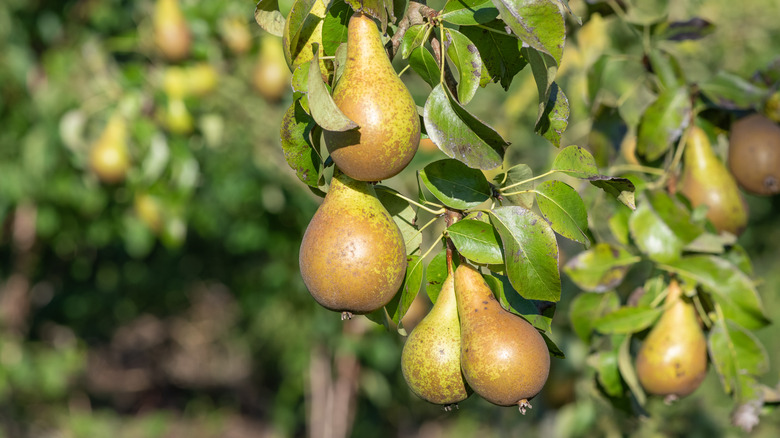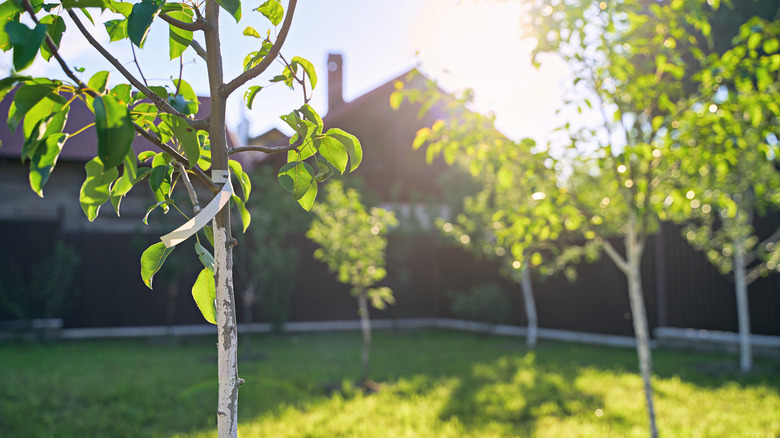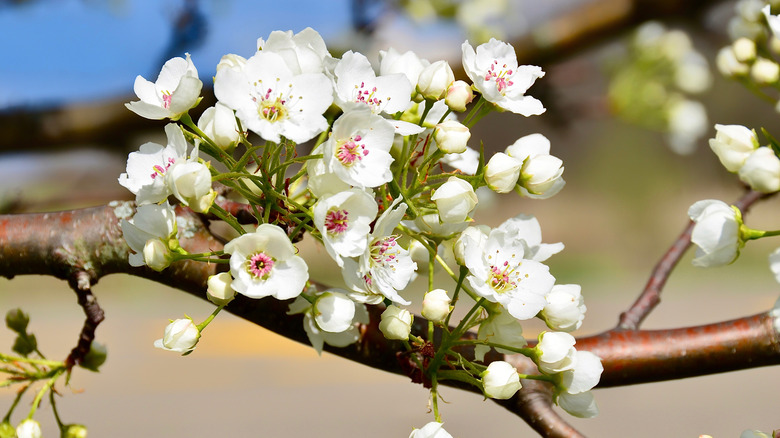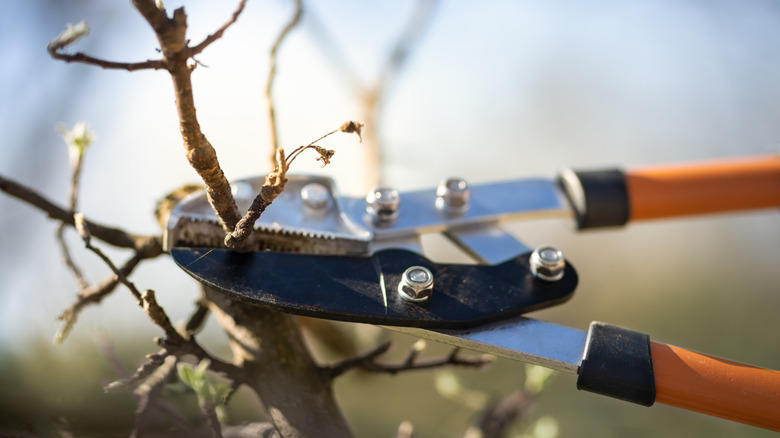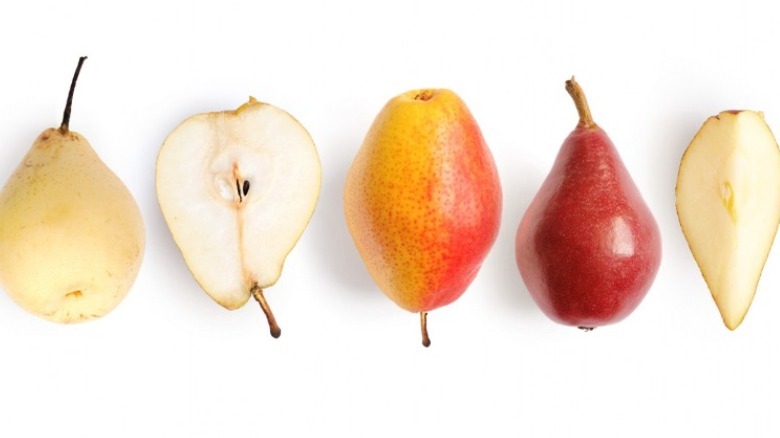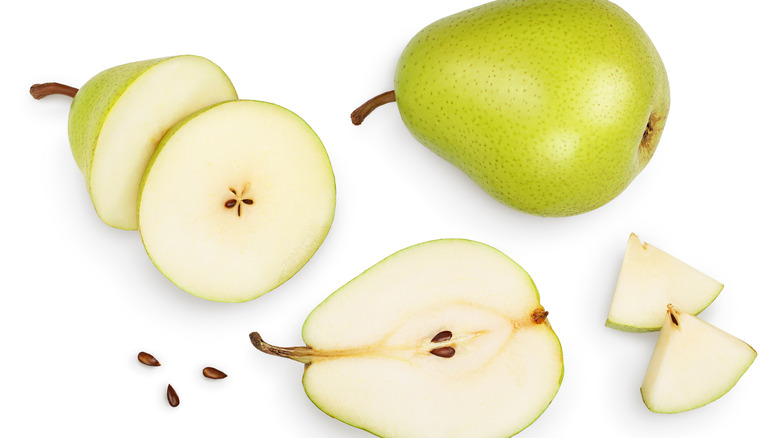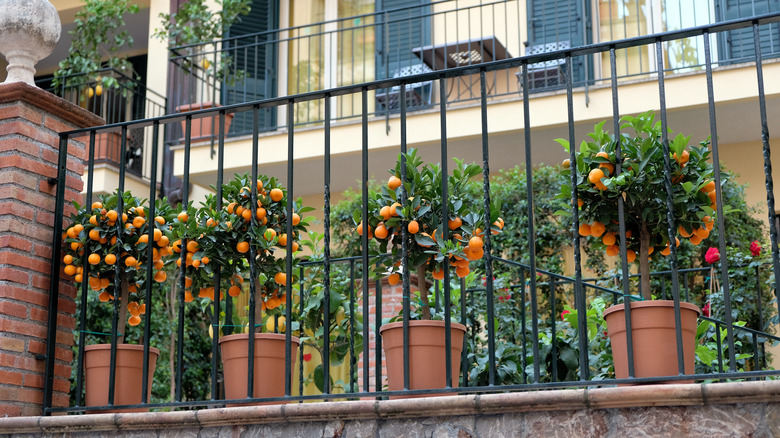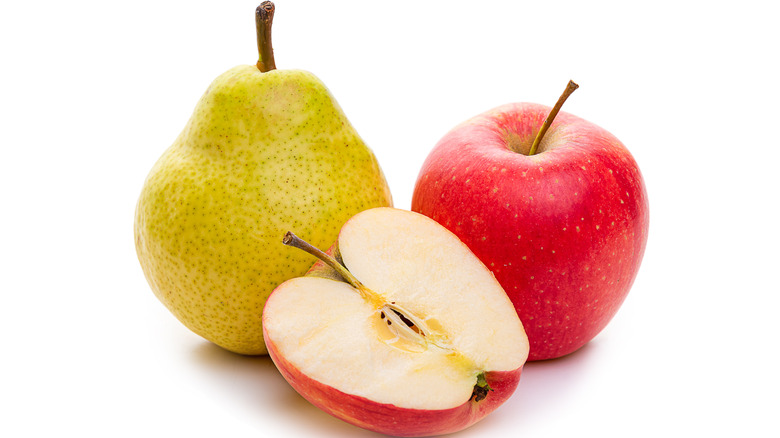How To Grow And Care For A Pear Tree
If you're looking for an easy-going, low-maintenance fruit tree for your yard, a pear tree (Pyrus sp.) is a great possibility. Botanically speaking, all pear trees are part of the Pyrus genus within the Rosaceae family and come originally from Asia. Masterclass surmises that they are particularly popular for many reasons. Not only do they produce delicious fruit, but it also doesn't take much work to get them to do so. Pear trees are hardy, pest-resistant, and easy to grow. They can also be pruned to maintain their shape within tight spaces. And let's not forget the flush of tiny white blossoms that will cover each and every branch at the beginning of spring, one of the most delightful signs that winter is truly over.
Pear trees will provide shade throughout summer and, come fall, you'll have plenty of fruit to reap. You can eat them right off the tree, slice them for salads, bake them into pies and muffins, or cook them as part of savory dishes from around the world. There are so many ways to enjoy this versatile fruit that Taste of Home has come up with over 50 delectable pear-themed recipes. You can't go wrong with a pear tree, so keep reading for everything you need to know to successfully grow and care for them.
How to use in garden
Most pear trees need to spend an extensive period of time in cold temperatures below 45 degrees Fahrenheit. These are called chill hours and they are necessary for flower production. Because of this, pears naturally do well in USDA hardiness zones three through ten. There are, however, newer cultivars that have been developed for warmer climates, notes IFAS Extension of the University of Florida. So wherever you are located, there's a pear tree that will work within your area's temperature and weather fluctuations.
Pear trees do not take up a large amount of space, but if you only have room for one tree or if you're intending to grow it in a container, you need to choose one from the shorter list of self-pollinating varieties. University of Minnesota Extension notes that, in order to cross-pollinate and bear fruit, pear trees usually need to be grown next to other varieties of pears. If you have the space, this could be the perfect excuse to create a mini orchard. If not, you might just need to offer one to your neighbor as a gift. For the most fruit, plant your trees in the sunniest spot you can, and don't be discouraged if it takes a while for them to get going. Your orchard may look underwhelming for its first few years but whatever quantity you end up with, they will (eventually) add a blissful explosion of spring blossoms followed by leafed-out, bright green foliage through the summer.
How to grow pear trees
A new pear tree can be cultivated by grafting an established young tree in early spring. This is a technique that requires refrigeration, stem whittling, scaffolding branches, and much more, according to Earthwise by Augusta Magazine on YouTube. Frankly, it's an involved process and may not be practical for the home gardener. Luckily, there is a much easier way to become a novice orchardist, and this is through rooted stem cuttings.
According to Gardener's Path, first, take a cutting from a mature tree. During spring and early summer, you can cut a softwood stem from a green area of new growth. Softwood cuttings root faster than others, but it's important to keep them sufficiently watered. Later in the season, new growth on a mature tree will become brown and hard and will take longer to root.
Cuttings do not need soil. They can instead be planted in a mix that contains sand, peat moss, vermiculite, and perlite. Rooting hormone, humidifiers, and heating mats are all recommended to help your cuttings become saplings. Gardener's Path also advises using a clear plastic cup to complete this rooting process. That way you'll be able to monitor your cutting's growth progress and repot it into fresh soil once its roots have surpassed 2 inches in length.
How to care for pear trees
Pruning is a major part of maintaining pear trees and should be performed during winter when branches are free of leaves. Pruning shapes trees while removing diseased or decaying branches. Heading cuts are typically performed on young trees to trim and clean up the ends, as well as to encourage new bud growth. Through their YouTube channel, Sid Hill Ecological Gardens shows how to remove dead limbs at the point where they meet larger branches, either by hand or with sharp clippers. Thicker branches will require a large set of pruning shears or a saw. Also, look for areas where branches scrape against each other. Just like a cut on human skin, these raw spots on the trees create an entryway for fungal diseases. In this case, cut the offending branch all the way down at the trunk level.
Another important aspect of pruning is opening up space for sunlight and air to penetrate the interior branches, both of which are required for growing and ripening fruit. These thinning cuts are much more extensive and won't need to be done until your tree is older. You may need to remove some of the largest branches in order to properly thin your pear tree. This can feel nerve-racking at the first attempt, but try to remember how vital it is to overall health.
Pear tree varieties
Bosc, green and red Anjou, Bartlett, Comice — these are just a few of the most well-known varieties of delicious pears you're likely to find at an autumn farmer's market, if not your local grocery store. Per USA Pears, there are ten fruiting varieties to choose from in the U.S. Some of these will be dessert pears — the sweetest and juiciest varieties we all love to eat — while others will be firmer and more tart (similar to a granny smith apple) making them better for cooking.
Historically, fruiting pear trees were found in northern climates with frozen winters, but new varieties have been adapted to grow in the hotter areas down south. According to University of Florida's IFAS Extension of Orange County, Flordahome, Hood, and Pineapple pear trees can all grow in locations as warm as USDA hardiness zone nine.
There are also many more types of flowering pear trees that are considered ornamental. These produce small fruit, similar to crabapples, that are suitable for birds yet inedible for humans. Their flowers offer a delightful welcome to the spring season and attract so many chirping birds to your yard that you might not even miss the tasty fruit that the other varieties bear.
Are pear trees toxic?
The toxicity of pear trees can be a little tricky to figure out. Generally speaking, we have nothing to worry about when it comes to pear trees, leaves, flowers, and fruit. The problem lies in the seeds, which contain cyanide. Garden Guides explains that, at best, cyanide poisoning can cause gastrointestinal distress. At worst, however, it can be lethal. Remove the seeds anytime you are giving pears (and certain other fruits like apples and cherries) to children and keep them away from pets.
There is also one specific variety of tree, the callery pear (Pyrus calleryana), which has wreaked a different kind of toxicity on the land. According to The Washington Post, the specific cultivar known as the Bradford pear, developed in the 1960s by botanists at the U.S. Department of Agriculture, was cloned and planted all over the country. It is a beautiful, almost impossible-to-kill tree that bursts into the beautiful blooms like the others, but unfortunately, that's not all. Since it was first planted, the Bradford pear tree has developed spikes that cannot be mowed and weak limbs that cause serious damage when they break and fall. It has also become an invasive species that can completely choke out native plants. In sum, it's absolutely fine to grow a pear tree in your yard, just be sure to stay far away from callery pears and, specifically, the Bradford variety.
How to repot a pear tree
For all you folks with a severe lack of garden space or even no yard at all, we've got great news — dwarf pear trees in pots are definitely a thing! And even better yet, they only need to be repotted every few years. Nature Hills Nursery, via YouTube, stresses that drainage is your number one concern. So, when your pear tree shows signs that it's ready for a bigger pot, focus first on setting it up for successful watering. One thing you can do before you add a potting mixture is to make sure that each hole in the bottom of your new container is at least an inch wide.
Coconut coir is highly recommended as a potting soil amendment for two reasons. It retains moisture, which cuts down on overall watering, and the size of its chunks aerates the soil to encourage drainage of any excess water. Pour a small amount of potting mix into the new pot and place the entire root ball of your pear tree on top of it. Backfill with more soil around all sides, tamping down to hold it steady. Don't overfill the pot, leave a space between the top of the soil and the top edge of the container to help keep water from spilling over. Finally, cover with mulch to further increase water retention.
A pear a day
Are you an apple person or a pear person? If you've typically gone the apple-a-day way, we've got some health-based information that just might sway you to the pear side. Food to Live's Healthy Blog has compared the nutritional content of these two fruits, and while it's true that they are very similar, pears take the lead in a few important ways. Pears are better at staving off hunger because they have less overall sugar combined with higher fiber content. This also aids in diabetes management by regulating blood sugar. Apples win in the vitamin department, but when it comes to minerals it's all about pears. They edge out their competition with higher levels of copper, which is an antioxidant. They also boast increased calcium, zinc, magnesium, and iron.
The health benefits of this mighty fruit don't stop there. The additional copper plus other antioxidants such as vitamins C and K fight the forces that cause premature aging and they may even help keep cancer at bay. Pears are fantastic for our digestive and cardiovascular systems, too. Any way you slice it, pears are an excellent addition to a balanced diet.
